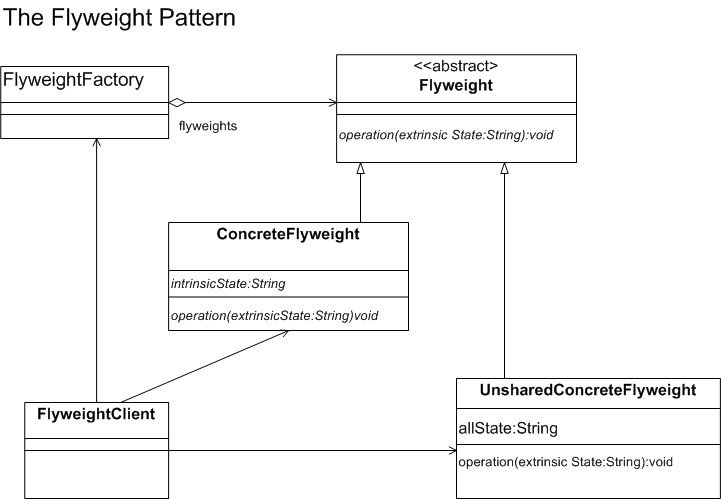The Flyweight Pattern: Role and Function in Structural Patterns
What is the role and function of the Flyweight Pattern within the context of Structural Patterns?- Introduction:
In the sophisticated world of software design, structural patterns emerge as a set of guiding principles, shaping the interconnections and relationships of classes and objects. The Flyweight Pattern carves a distinctive niche within this realm. At its essence, this pattern seeks to optimize systems by promoting the reuse of shared objects in contexts where vast quantities of objects bearing almost identical states are used, thereby conserving system resources. - Role of the Flyweight Pattern:
The Flyweight Pattern’s cardinal role is anchored in its endeavor to enhance the efficiency and scalability of systems. It grapples with the challenge of managing large numbers of fine-grained objects, aiming to reduce the memory and resource overhead.
2.1. Primary Roles:- Resource Optimizer: The Flyweight Pattern substantially diminishes the memory footprint by sharing objects, ensuring efficient utilization of resources, particularly in memory-constrained environments or high-performance applications.
- System Scalability Enhancer: By mitigating the overhead associated with large object instantiations, it paves the way for systems to scale more effectively in the face of extensive object requirements.
- Function of the Flyweight Pattern:
This pattern distinguishes between intrinsic and extrinsic states, allowing the shared use of objects with similar intrinsic states while externalizing other states.
3.1. Key Components:- Flyweight: An interface that enforces the behaviors of flyweight objects. It typically contains methods that apply to both intrinsic and extrinsic states.
- ConcreteFlyweight: Implements the Flyweight interface and is responsible for storing the intrinsic state. This state must be shared and is typically immutable.
- FlyweightFactory: A utility class responsible for creating and managing flyweight objects. It ensures that flyweights are shared appropriately, often employing a system of caching.
- Client: Engages with the Flyweight and FlyweightFactory. Clients should be configured to maintain the extrinsic state, while the Flyweight provides the intrinsic state.
3.2. Operational Analysis:- The client requests a flyweight from the FlyweightFactory, specifying the intrinsic state.
- The FlyweightFactory provides an existing instance or creates a new one if none exists for the given state.
- The client configures the flyweight with the external state and then executes operations on the flyweight.
- Analytical Considerations
- State Decoupling:The crux of the Flyweight Pattern rests on the bifurcation of state. Intrinsic states are shared and immutable, whereas extrinsic states remain external to the flyweight, allowing for dynamic interactions without affecting the shared model.
- Memory vs. Computation Trade-off: While memory usage is optimized, there's an increase in computational overhead. The process of managing, looking up, and configuring flyweights can introduce performance costs, especially in high-frequency scenarios.
- Applicability Constraints: The efficacy of the Flyweight Pattern is contingent upon scenarios where large numbers of objects with overlapping states exist. In scenarios where object states are largely unique, the benefits of this pattern diminish.
- Conclusion:
The Flyweight Pattern stands as an analytical testament to the architectural finesse in structural patterns. It masterfully addresses the conundrums posed by systems inundated with multitudes of similar objects. Through an astute division of intrinsic and extrinsic states, it achieves an equilibrium between memory optimization and object granularity. Yet, it is imperative for architects and developers to judiciously discern its applicability, ensuring that the trade-offs align with the system's performance and architectural requirements. In analytical retrospection, the Flyweight Pattern epitomizes the structural pattern's objective: to harmonize efficiency with structural integrity.
The Flyweight pattern reduces the number of low-level, detailed objects within a system by sharing objects.
If instances of a class that contain the same information can be used interchangeably, the Flyweight pattern allows a program to avoid the expense of multiple instances that contain the same information by sharing one instance. The figure below illustrates the Flyweight pattern.
The Flyweight pattern defines a structure for sharing objects. Objects are shared for at least two reasons: 1) efficiency and 2) consistency. The Flyweight pattern focuses on sharing for space efficiency. Applications that use lots of objects must pay careful attention to the cost of each object. Substantial savings can be achieved by sharing objects instead of replicating them.
But objects can be shared only if they do not define context-dependent state. Flyweight objects have no such state. Any additional information they need to perform their task is passed to them when needed. Because they have no context-dependent state, Flyweight objects may be shared freely.
But objects can be shared only if they do not define context-dependent state. Flyweight objects have no such state. Any additional information they need to perform their task is passed to them when needed. Because they have no context-dependent state, Flyweight objects may be shared freely.

Benefits:
The following lists the benefits of using the Flyweight pattern:
- Reduction in the number of objects to handle
- Reduction in memory and on storage devices, if the objects are persisted
When to Use:
You should use the Flyweight pattern when all of the following are true.
- The application uses a large number of objects.
- Storage costs are high because of the quantity of objects.
- The application does not depend on object identity.